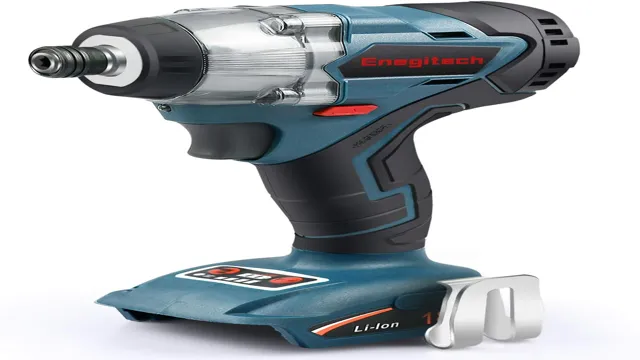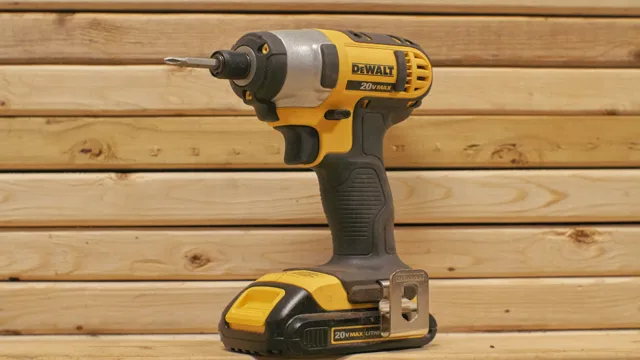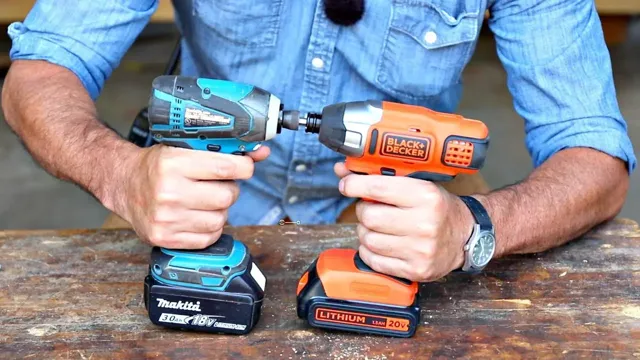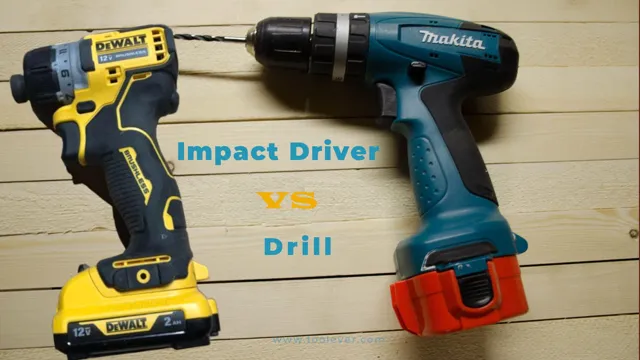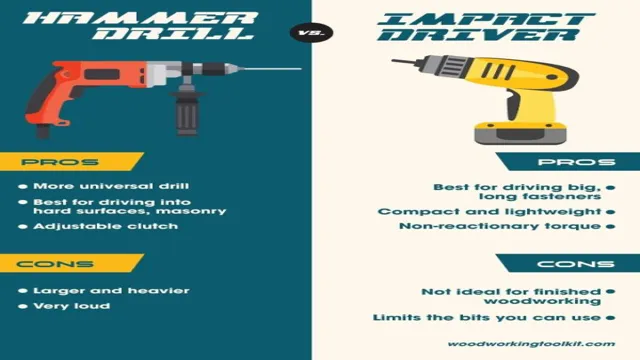Is Impact Driver Same as Drill? Know the Key Differences & Choose the Right Tool for Your Job!

Have you ever found yourself standing in front of a wall with a drill in one hand and an impact driver in the other, wondering which one to use? You’re not alone. As a homeowner or DIY enthusiast, it’s essential to know the differences between the two tools. Although they may look similar at first glance, they serve different functions.
Using the wrong tool for the job can lead to frustration and even damage to your workpiece. In this blog post, we’ll dive into the key differences between an impact driver and a drill, to help you choose the right tool for your next project.
Overview
Are impact drivers the same as drills? This is a question many people ask when they are trying to decide which tool to use for their project. The answer is no, impact drivers are not the same as drills. While both tools can drill holes and drive screws, they are designed for different types of work.
A drill is great for drilling holes and driving screws into soft materials like wood or drywall. It has a chuck that holds drill bits or screwdriver bits securely in place. Impact drivers, on the other hand, are designed for tougher jobs.
They can drive screws into hard materials like metal, brick, and concrete with ease. They have a quick-release chuck that makes it easy to change out screwdriver bits. Impact drivers also have a feature called an impact mechanism that delivers more torque than a drill, which makes it easier to drive screws into harder materials.
So, while both tools have similar functions, they are not interchangeable. It’s important to choose the right tool for the job to ensure that your project is completed efficiently and effectively.
Definition of Impact Driver and Drill
Impact Driver, Drill Impact drivers and drills are two of the most common power tools used for drilling and fastening. Both tools are designed to help users complete DIY projects and professional jobs with more ease and speed. Although they may look similar, they function differently, and each has its unique features that make it useful in different applications.
A drill is primarily used for drilling holes in a wide range of materials such as wood, plastic, and metal. It uses a twisting motion to bore a hole through the material. On the other hand, an impact driver is a powerful tool designed for driving fasteners such as screws and bolts into tough materials such as concrete, brick, and steel.
It is equipped with a bit that rotates in a circular motion and combines an impact mechanism that delivers quick bursts of torque to make driving screws or bolts more comfortable and less time-consuming. Whether you need to bore holes or drive screws, an impact driver or drill can help you complete your project with minimal effort and time.

Key Differences between Impact Driver and Drill
Impact driver, Drill, Differences When it comes to power tools, people often confuse an impact driver with a drill. While they may look similar, there are significant differences between the two that you should understand before deciding which one to purchase. An impact driver is a powerful tool that delivers high-torque, rotational force.
It’s primarily used for driving screws and bolts into tough surfaces like wood, metal, and concrete. A drill, on the other hand, is a versatile tool that drills holes and drives screws, but it delivers less torque than an impact driver. So, if you’re looking for a tool that can handle heavy-duty fastening jobs, an impact driver may be the better choice for you.
But, if you need a tool that can handle a range of tasks, a drill might be more suitable. By understanding the key differences between these two power tools, you can make an informed decision when it comes to choosing the right tool for your needs.
Impact Driver vs Drill: Which Is Ideal for Your Needs?
Many people often confuse an impact driver with a drill, assuming they are the same tool. However, this is not the case. An impact driver is designed to deliver strong, sudden rotational force, while a drill is primarily used for drilling holes or driving screws with a constant torque.
Impact drivers are perfect for tasks that require driving long or large screws, while drills are better for lighter tasks. For instance, if you’re planning on doing a task that involves sinking some woodworking screws deep into hardwood, an impact driver is your best bet. On the other hand, if you’re just looking to drill a few holes or drive screws into a drywall, a drill will get the job done effectively.
Ultimately, the ideal tool for your specific needs will depend on the type of project you’ll be working on, the type of material you’ll be working with, and the kind of screws you’ll be using.
Impact Driver Use Cases
Impact Driver vs Drill: Which Is Ideal for Your Needs? When it comes to DIY projects, it’s important to have the right tool for the job. Impact drivers and drills are both commonly used for fastening and drilling applications, but they have distinct differences. Impact drivers are designed for high-torque applications, making them ideal for driving long screws or working with tough materials like concrete.
Drills, on the other hand, are typically used for lighter-duty projects like drilling holes in wood or metal. If you’re looking for versatility, a drill may be the better option since it can be used for both drilling and driving screws. However, if you need a tool that can handle tough jobs with ease, an impact driver may be the way to go.
Another factor to consider is comfort, as impact drivers tend to be lighter and easier to handle than drills due to their compact design. Ultimately, choosing between an impact driver and a drill comes down to the specific job you’re working on. If you need a tool for heavy-duty projects or driving long screws, an impact driver is the better choice.
For lighter jobs and versatility, a drill may be the way to go. Keep in mind that some projects may require both tools, so it’s always a good idea to have both on hand.
Drill Use Cases
When it comes to power tools, one of the most common dilemmas people come across is whether to use an impact driver or drill for their needs. Both these tools have their strengths and weaknesses, and choosing the right one depends on the task at hand. If you’re looking for more power and speed for heavy-duty jobs such as driving long screws or drilling into tough materials like concrete, an impact driver is a better choice.
It has a higher torque that can handle the toughest of jobs with ease. On the other hand, a drill is a more versatile tool, with a clutch that can be adjusted to handle different screw-driving tasks. It’s also the go-to tool for any drilling needs, especially for precision works such as making holes in wood or drywall.
Ultimately, the choice between an impact driver vs drill depends on the job you need to accomplish. If you need brute force and speed, go with an impact driver. If you need versatility with the ability to adjust torque, go with a drill.
Factors to Consider When Choosing Impact Driver or Drill
When it comes to choosing between an impact driver and a drill, there are a few factors to consider to determine which is ideal for your needs. Impact drivers are great for jobs that require high torque and fast speeds, such as driving long screws into hard materials like wood or metal. On the other hand, drills are better suited for jobs that require precision, like drilling small holes or driving small screws into delicate materials.
It’s also important to consider the size and weight of the tool, as well as the type of battery it uses. Do you need a compact and lightweight tool that’s easy to maneuver in tight spaces, or are you willing to sacrifice portability for a more powerful tool? Lastly, consider your budget and how much you’ll be using the tool. While impact drivers tend to be more expensive than drills, they can also last longer and handle tougher jobs.
Ultimately, it all comes down to what type of work you’ll be doing and what features are most important to you.
Conclusion
In conclusion, while an impact driver and a drill may look similar, they are not the same tool! It’s kind of like asking if a bicycle and a motorcycle are the same thing just because they both have wheels and handlebars. An impact driver is designed to deliver high torque for driving screws and fasteners, while a drill is more versatile and can be used for various tasks such as drilling holes and driving screws. So, next time you’re deciding which tool to use, remember that the impact driver and the drill are like two different vehicles with their own unique purposes.
Happy building!”
FAQs
What is the difference between an impact driver and a drill?
While both tools can drill holes and drive screws, an impact driver delivers higher torque and is typically used for heavy-duty jobs, while a drill is more versatile and can be used for a wider range of tasks.
Can you use impact driver bits in a drill?
Yes, you can typically use impact driver bits in a drill, but it’s not recommended to use drill bits in an impact driver.
Are impact drivers better than drills?
It depends on the task at hand. Impact drivers are better for heavy-duty jobs like driving long screws or bolts, while drills are better for general use and can be outfitted with a wider range of bits.
What is the maximum torque of an impact driver?
The maximum torque of an impact driver varies by model, but can range from 1,000 to 2,000 inch-pounds or more.
Can an impact driver be used as a drill?
While an impact driver can technically be used as a drill, it is not recommended as it may not provide the necessary precision or control for certain tasks.
How do you choose between an impact driver and a drill?
Consider the type of project you’ll be working on and choose the tool that is best suited for the job. If you’ll be driving long screws or bolts, an impact driver may be a better choice, while a drill is better for general use.
Are impact drivers louder than drills?
Yes, impact drivers are typically louder than drills due to the percussive action of the tool. It’s recommended to wear hearing protection when using either tool.



